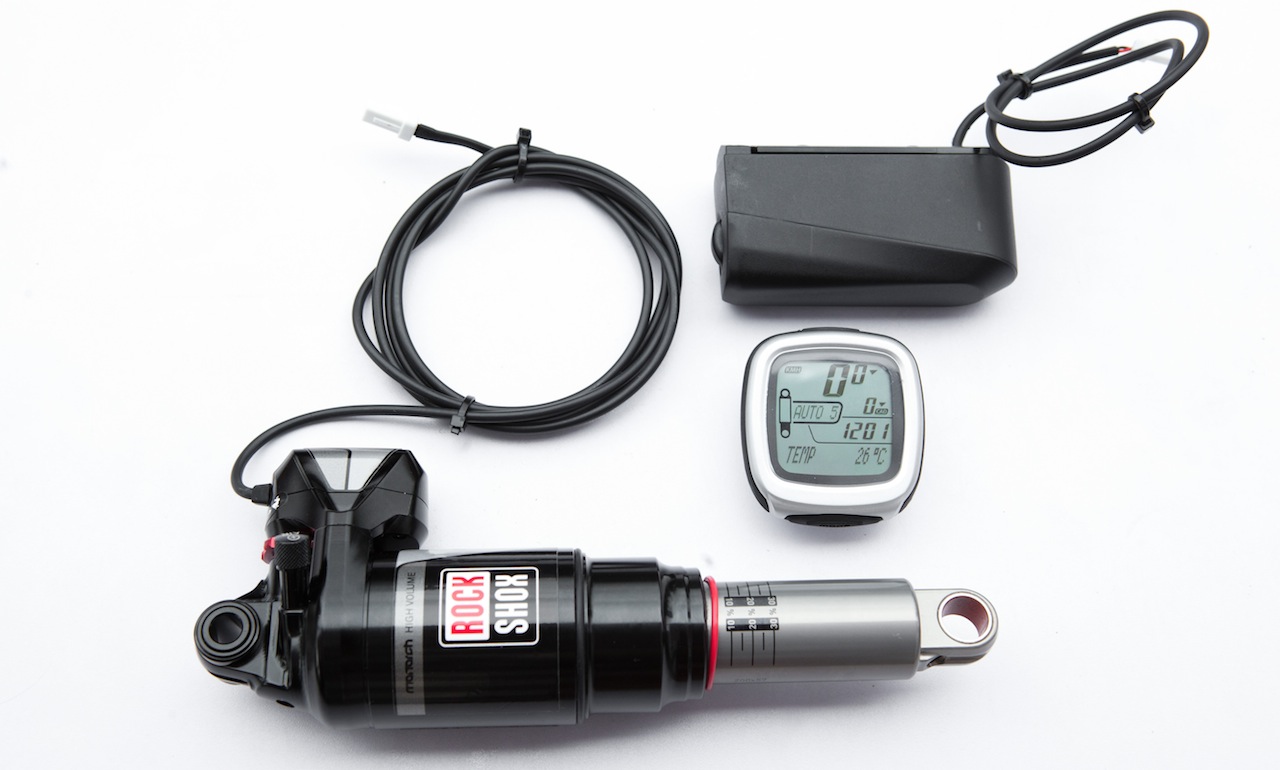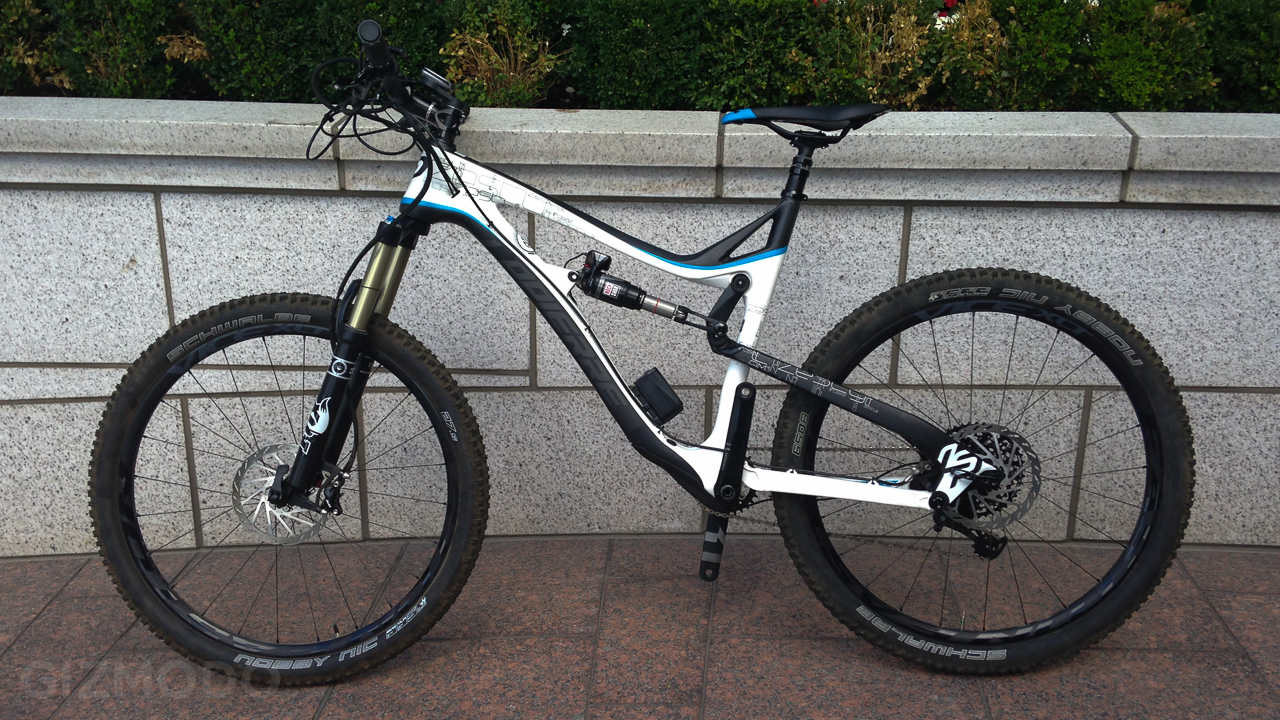If rode a mountain bike in the 1980s or 1990s, suspension was just a dream — something only the rich kids could afford. Gradually, however, it became a must-have feature for serious trail riders. It began with shocks in the front fork, and later evolved to full suspension with shocks on both wheels — and eventually, spring-driven suspension gave way to pneumatic. But there was a problem.
If you set your rear suspension to be too soft, you lose a lot of pedalling power because every time you stomp down the suspension absorbs the energy, so you lose a lot of that power when transferring it your drive train. Set the rear suspension too firm, though, and you’ll feel every little bump reverberate through your body. It’ll make your ride, bumpy, unstable, and uncomfortable. So which do you choose? One? The other? Something in between? Do you get off your bike every time you want to change the resistance?
You could do that. Or you could let this intelligent electric suspension system from LaPierre and RockShox deal with it for you.
Welcome to Fitmodo, Gizmodo’s gym for your brain and backbone. Don’t suffer through life as a snivelling, sickly weakling — brace up, man, get the blood pumping! Check back each week for the latest in fitness science, workout gear, exercise techniques, and enough vim and vigour to whip you into shape.

What Is It?
French bicycle company Lapierre and RockShox (a ubiquitous maker of bike suspension systems) spent five years of R&D dialling in the e:i, or “electronic intelligence”, shock system. It consists of several pieces: a bike computer with an accelerometer in it, a handlebar-mounted control switch, a second accelerometer in the front fork, a cadence sensor in the bottom bracket, a battery pack, and last but definitely not least, a Monarch Relay containing a servo motor that controls the compression of the shock (shown in the top image).
Those parts, when coupled with a compatible set of shocks (from RockShox), create a suspension system that automatically adjusts itself to the terrain and circumstances. For all that, it adds only 349g to your rig.
How It Works
Before you head out on the trail, you adjust your “sag”, or how much the rear shock compresses when you put your full weight on it. Too loose, and you could bottom out when you land from a jump or a drop, which could break your fork (or crotch). Too tight and all that vibration and bump is translated into your body. Most manufacturers recommend about a 25 to 30 per cent sag. You adjust the amount of sag using an air pump as per usual and head out.
From there, you can pretty much let the e:i system do its thing. It works like this: on the bike computer, select one of the auto modes. This engages the e:i system. From here on out, your rear suspension is paying attention to what happens in your front suspension. For example, when you’re sailing downhill without pedalling, the system will respond by opening up the rear suspension to absorb any bumps along the way. If you’re pedalling uphill, it’ll lock out your rear suspension so all of your pushing goes into the crank, not the shocks.
But what if you’re pedalling and it starts to get rough? Like, for instance, you’re pedalling over a bunch of smaller bumps and rough terrain. The e:i system will switch to “pedal” mode, which balances power transfer and smoothness. Hit a big bump, however, and the front accelerometer will take note, immediately opening up the rear suspension so your seat doesn’t send a shockwave up your spine. How fast is it? Try 0.1 seconds. Fast enough that if you could hit a big rock going 35km/h, the rear suspension would release before the rock hits your rear wheel. That’s damn impressive. Lapierre’s engineers estimate that on a typical ride, the e:i system will adjust your rear suspension 200 times. Can you imagine manually adjusting your bike that many times in an hour?
Now, about the user interface. The onboard computer gives you manual controls (and also displays your average speed, current speed, chronograph, distance, cadence, and the current position of the shocks). If you know you’re in for a long downhill section, you can use the toggle switch to flip it to open. If you know you’ll be climbing for a while, switch to locked mode. Or if you know you’ll be pedalling over some rough stuff, you can flip it to the pedal mode. But the automatic mode is how you engage e:i — within auto, there are five levels of sensitivity. Level 1 makes the threshold for bumps very low, easily releasing into the cushier open mode. Level 5 will take a much bigger bump before it releases the rear suspension. This is more for people who are going to be pedalling a lot and going for speed. Battery life is typically 25 hours of use on a single charge.

Using It
Last week I got the chance to test the e:i system on a couple Lapierre bikes: the Zesty All-Mountain and the XR (cross-country bike). The Zesty has a good deal more travel (the amount of motion the suspension can accommodate), so e:i’s presence was very noticeable. We set the sag to 30 per cent and set the computer to Auto 2, which meant it would be pretty liberal with suspension but wouldn’t go soft at the slightest bump in the road. You still have to manually leave the front fork’s suspension open, otherwise it has no travel and the accelerometer can’t tell your rear suspension when to open up.
While coasting in the downhill sections, the suspension opened up as advertised, and it made for a very smooth ride. I was clearing jumps, drops, tabletops, and landings easy-breezy (and I’m not a very accomplished mountain cyclist). As soon as we hit a climb, I could feel my rear suspension lock out. I tried the same stretch compared to having the suspension manually set to open, and it felt like normal biking versus biking through bubblegum. Then (still in e:i auto mode 2), if I hit a rock, I instantly felt everything get looser. This came in handy while pedalling up little hills only to find a gnarled tree-root right at the top — which seemed to happen a lot.
The suspension reacted fast enough that I never felt like I was going to get bucked off my seat while slamming into a rock. It gave me the confidence to hit jumps, teeter-totters, and steep berms that I wouldn’t have dared tackle otherwise. My experience wasn’t nearly as good on the XR, but that was really my own fault. I shouldn’t have selected a cross country bike for a fairly technical downhill course. It absolutely cruised on the uphills and in the flats, but I got into trouble on the downhill sections. My centre of gravity was too high, and there wasn’t enough grip on the tires or travel in the shocks. This culminated in me leaving a fair amount of shin, knee, hip, chest, and elbow skin on the mountain. Luckily I was wearing Google Glass, so there’s some choice POV footage of me eating copious amounts of shit.
Getting Them
The e:i shock system debuted on Lapierre’s high-end bikes last season, but they never made it to North America due to patent issues. Luckily, that’s in the past, and the e:i shock system will be available for the first time in the U.S. in January 2014. That’s the good news.
The bad news? E:i is exclusive to Lapierre’s high-end mountain bikes: the Spicy, Zesty AM, Zesty Trail, and XR. These bikes ain’t cheap. We’re talking $US8000 for the top-end carbon models, and around $US5000 for the lower-end versions that still come with e:i. In other words, this is a system designed for serious cyclists only. But if you’ve got the bread to drop on a new mountain bike, the e:i shock system will spoil you mighty fast. [Lapierre Bicycles]
Pictures: Manu Mole, David Schultheis, Lauren Fallert
